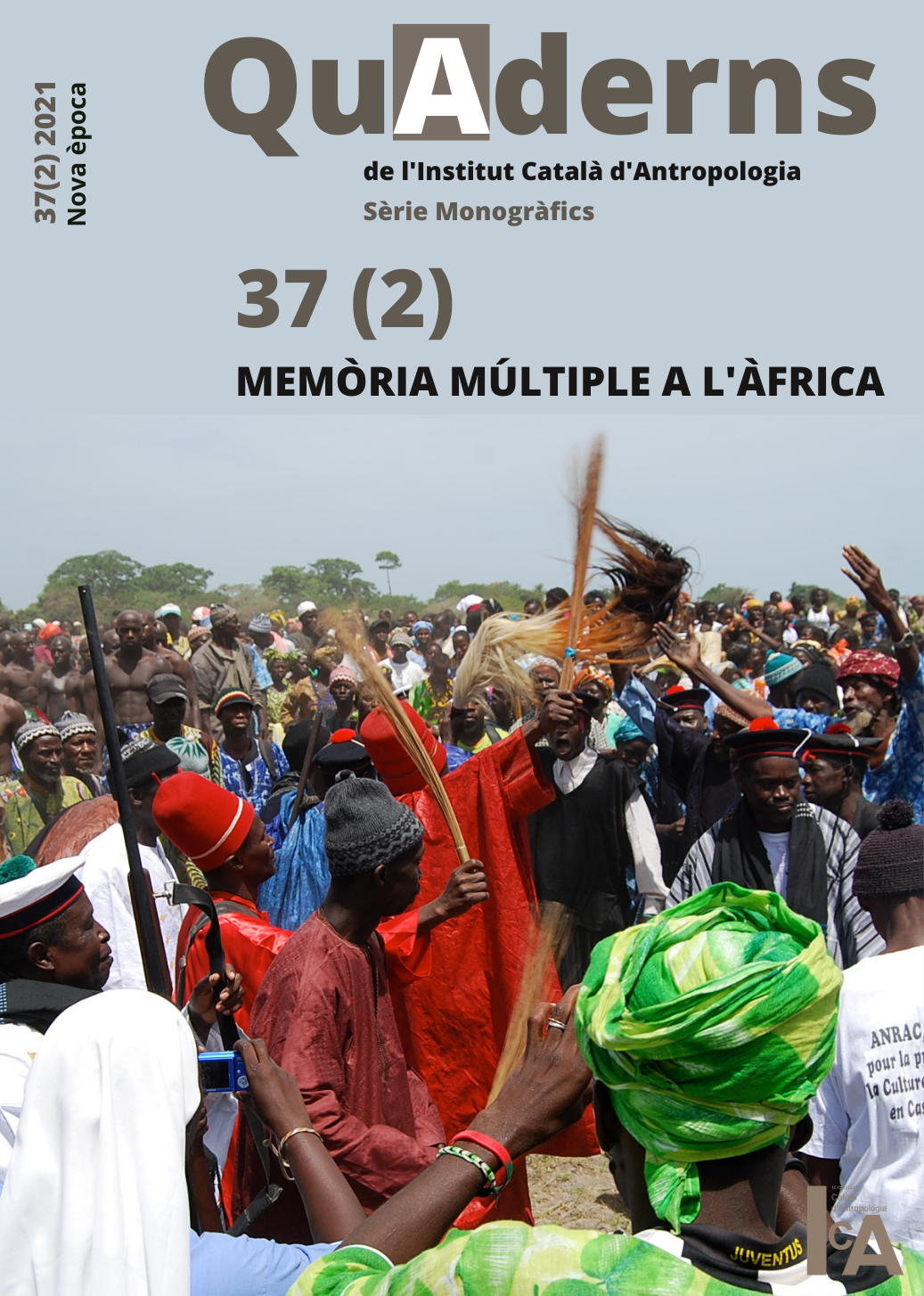Memòries múltiples, tradició i construcció de pau a Acholiland
DOI:
https://doi.org/10.56247/qua.366Paraules clau:
justícia tradicional, memòries múltiples, mato oput, LRAResum
La justícia tradicional al nord d’Uganda ha estat un dels pocs recursos que la població acholi ha tingut a la seva disposició per explicar el passat. El conflicte armat iniciat pel LRA el 1986 i que es va allargar fins el 2009 a Acholiland ha marcat les realitats de la regió septentrional del país, entre elles la manera com s’explica el conflicte. Des de fa més d’una dècada les memòries no oficials de la guerra han començat a fer-se fortes als marges de l’estat per crear altres relats, el que anomenem memòries múltiples. Per fer-ho, la cultura tradicional acholi, encarnada en les figures representatives dels rwodis, ha recuperat part del seu costumari per apropar la construcció d’una pau estable i duradora. Malgrat no sempre s’ha aconseguit, i amb tots els matisos necessaris, les cerimònies del mato oput han establert espais on les veritats de les disputes aparegudes durant i després del conflicte s’han pogut debatre i tractar sota una mirada local i pròpia. Amb una gran empenta econòmica per part de les ONGs, podem dir que durant l’última dècada en dia, tant el mato oput com els rwodis, s’han consolidat com actors de la construcció de pau i memòries múltiples.
Descàrregues
Global Statistics ℹ️
|
287
Views
|
208
Downloads
|
|
495
Total
|
|
Referències
Allen, T. (2008). La justice traditionnelle est-elle une alternative viable à la cour pénale internationale? Mouvements, 53(1), 118-124. DOI: https://doi.org/10.3917/mouv.053.0118
Allen, T. (2007). The International Criminal Court and the invention of traditional justice in Northern Uganda. Politique Africaine, 107(3), 147-166. DOI: https://doi.org/10.3917/polaf.107.0147
Atkinson, R. (2009). From Uganda to the Congo and Beyond: Pursuing the Lord’s Resistance Army. International Peace Institute, 6-13.
B. Rubongoya, J. (2007). Regime Hegemony in Museveni‘s Uganda: Pax Musevenica, (1ª ed.), Palgrave Macmillan. DOI: https://doi.org/10.1057/9780230603363
Bayart, J.F. (2000). Africa in the world: A history of extraversion. African Affairs, 99(395), pp. 217-267. DOI: https://doi.org/10.1093/afraf/99.395.217
Branch, A. (2004). International Justice, Local Injustice. The International Criminal Court in Northern Uganda. Dissent, 51(3), 22-26.
Dolan, C. (2000) Inventing traditional leadership? A critical assessment of Denis Pain’s ‘The Bending of the Spears (1ª ed.). Acord COPE Working Paper, 31.
Farré, Albert (2005). Enfermedades, espíritus y revolución. El levantamiento de las Holy Spirit Mobile Forces en el norte de Uganda (1986-1987). Dins Roca, Albert (Coord.). La revolución pendiente: el cambio político en el Africa negra (pp. 261-286). Universitat de Lleida.
Komujuni, S. (2019). To be a chief and to remain a chief: The Production of Customary Authority in Post-Post Conflict Northern Uganda. (Tesis doctoral). Uganda Martyrs University.
Komujuni, S. i Büscher, K. (2020). In search of chiefly authority in ‘post-aid’ Acholiland: transformations of customary authorities in northern Uganda. Journal of Eastern African Studies, 14(1), 103-124. DOI: https://doi.org/10.1080/17531055.2019.1711312
Létourneau, J. i Jewsiewicki. (2003). B. Politique de la mémoire. Politique et Sociétés, 22(2), 3-15. DOI: https://doi.org/10.7202/007871ar
Meier, B. (2013). “Death Does Not Rot”: Transitional Justice and Local ‘Truths’ in the Aftermath of theWar in Northern Uganda. Africa Spectrum, 48(2), 25-50. DOI: https://doi.org/10.1177/000203971304800202
Navarro Millan, I. (2019). Una mirada comprensiva sobre la recurrencia de la violencia política armada en Uganda: recuperando el papel constitutivo del estado, lo internacional y la agencia de los actores armados. (Tesis doctoral). Universidad Autónoma de Madrid.
Nono, F. (2018). Legacy of conflict in Northern Uganda: To Forget or to remember? New Vision.
Pain, D. (1997). “The Bending of Spears”: producing consensus for peace & development in Northern Uganda (1ª ed.). International Alert.
Perrot, S. (2010). “Who’s the bull in the Kraal?” Guerre et mémoires et guerres de mémoire dans l’est de l’Ouganda. Cahiers d’études africaines, 197(50), 153-179. DOI: https://doi.org/10.4000/etudesafricaines.15821
Quinn, J. (2014) Traditional Cultural Institutions on Customary Practices in Uganda. Africa Spectrum, 49(3), 29-54. DOI: https://doi.org/10.1177/000203971404900302
Rodríguez Soto, J.C. (2009). Conflicto y gobernabilidad en el norte de Uganda. Posibilidades y límites de los ritos de reconciliación mato oput. Dins Farré, Albert i Tomàs,
Jordi (Coords.): Revista CIDOB d’Afers Internacionals, 87(2), 147-166.
Royo, J.M. (2008). Escenarios de paz y de guerra en el Norte de Uganda. Quaderns de Construcció de Pau, 6.
Stupard, R. (2015). Recording the War: An assessment of Uganda‘s National Memory and Peace Documentation Centre conflict dataset. (Tesis Doctoral). London School Of Economics.
The Refugee Law Project. (2005). Peace first, justice later: Traditional Justice in Northern Uganda. Refugee Law Project Working Paper, 17.
The Refugee Law Project. (2005). Whose justice? Perceptions of Uganda’s Amnesty Act 2000: the potential for conflict resolution and long-term reconciliation. Refugee Law Project Paper, 15.
The Refugee Law Project. (2004). Behind the violence: causes, consequences and the search for solutions to the war in Northern Uganda. Refugee Law Project Paper, 11.
Ubink, J. (2008). Traditional Authorities in Africa. Resurgence in an Era of Democratisation. Leiden University Press. DOI: https://doi.org/10.5117/9789087280529
Vinck, P., Pham, P. N., Stover, E., & Weinstein, H. M. (2007). Exposure to war crimes and implications for peace building in northern Uganda. JAMA, 298(5), 543–554. DOI: https://doi.org/10.1001/jama.298.5.543
Descàrregues
Publicades
Com citar
Número
Secció
Llicència
(CC BY-NC-SA 4.0)




